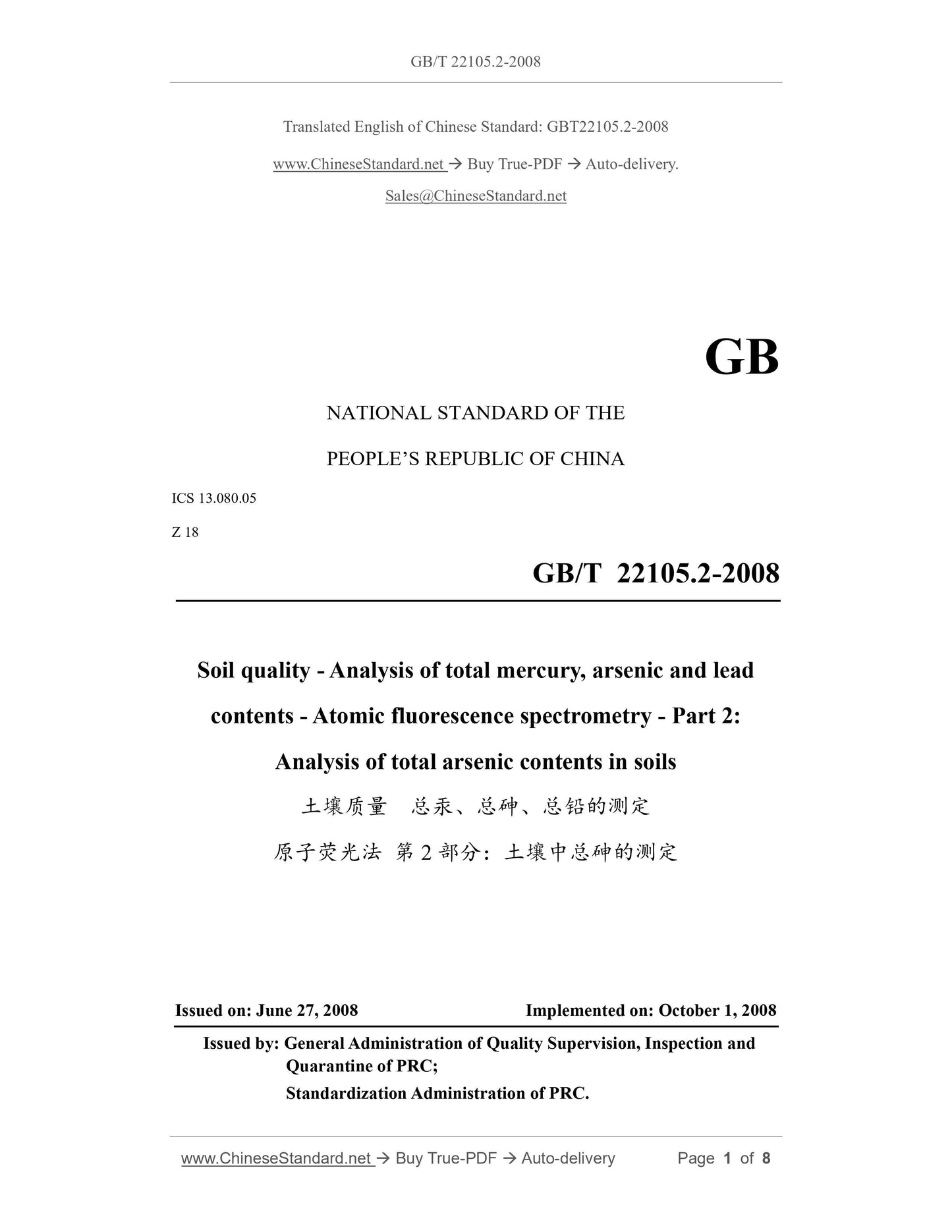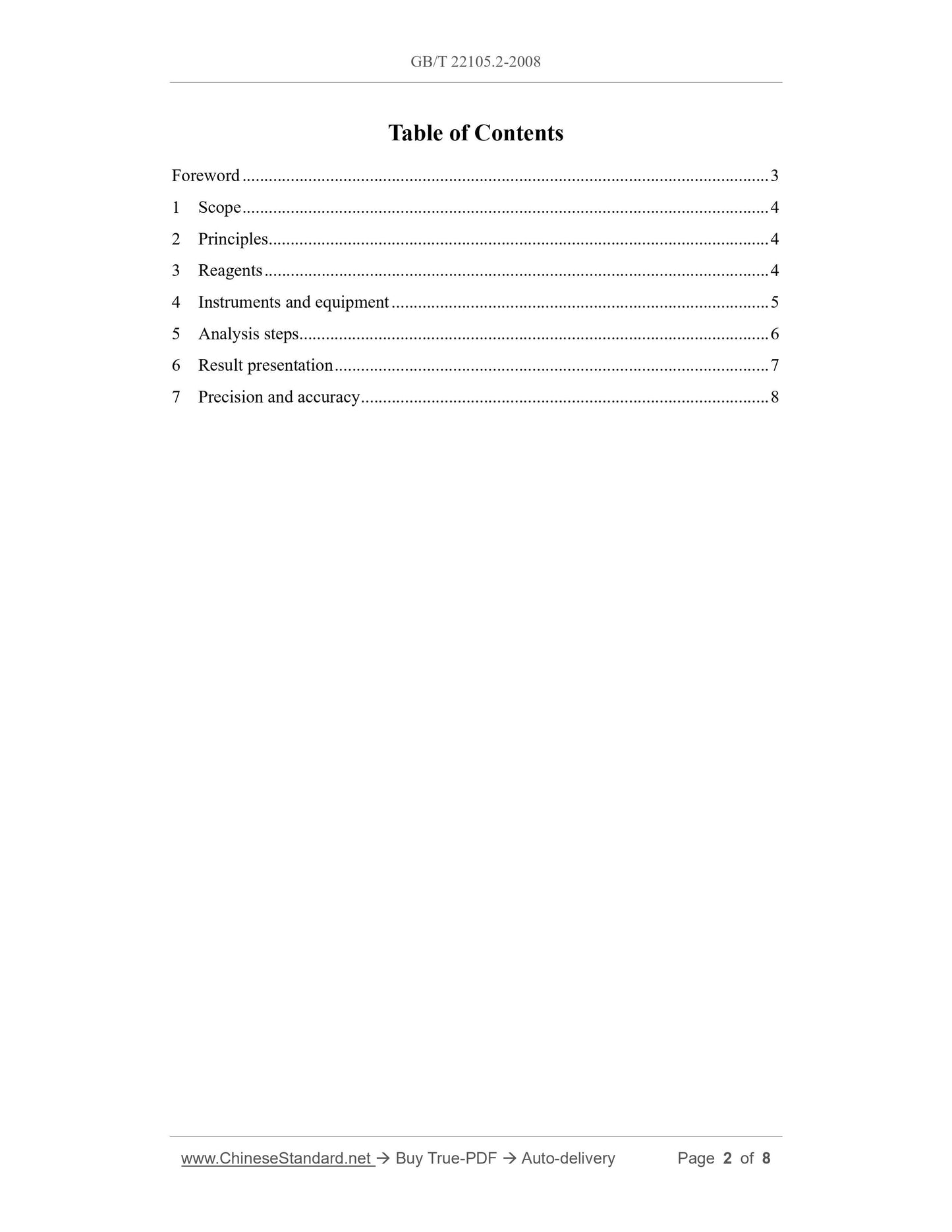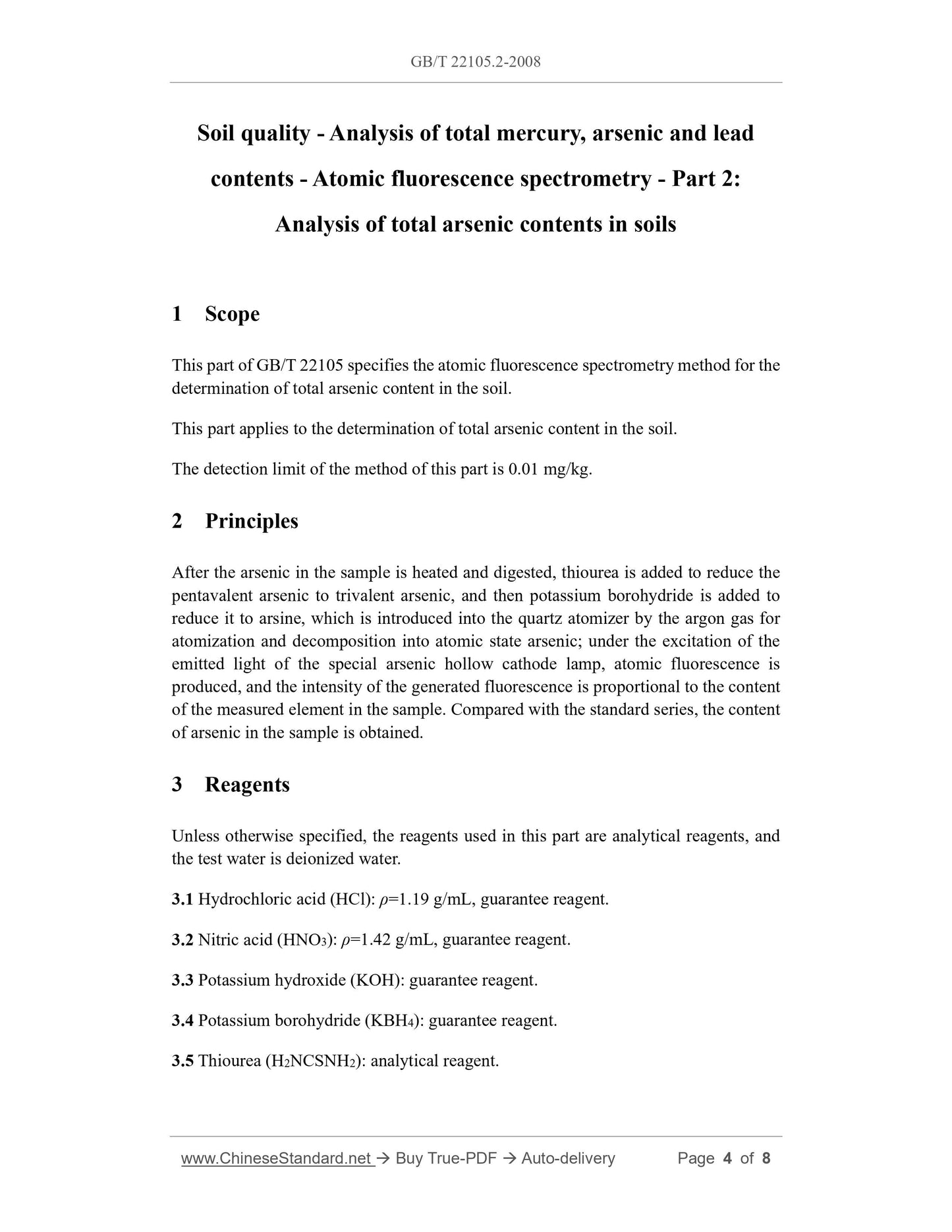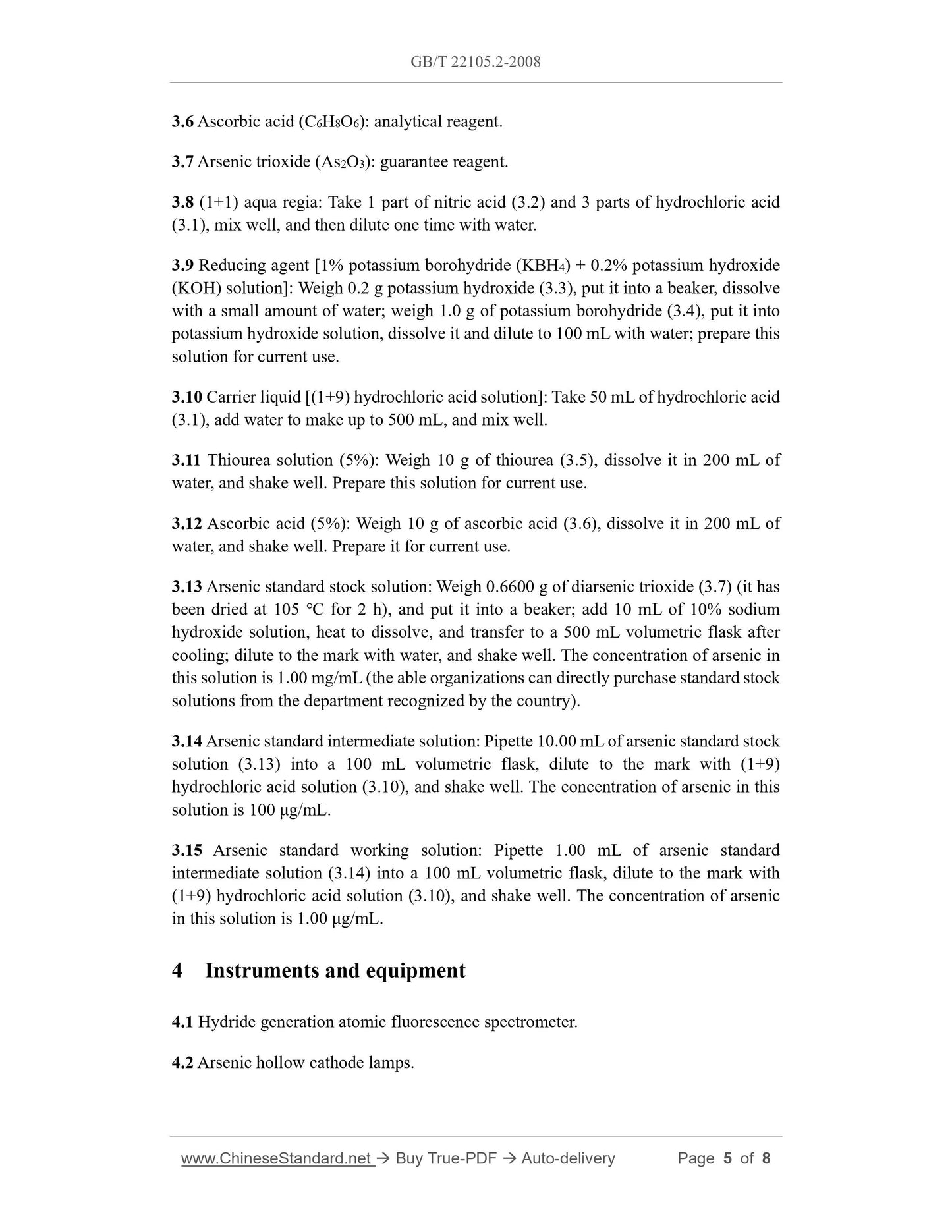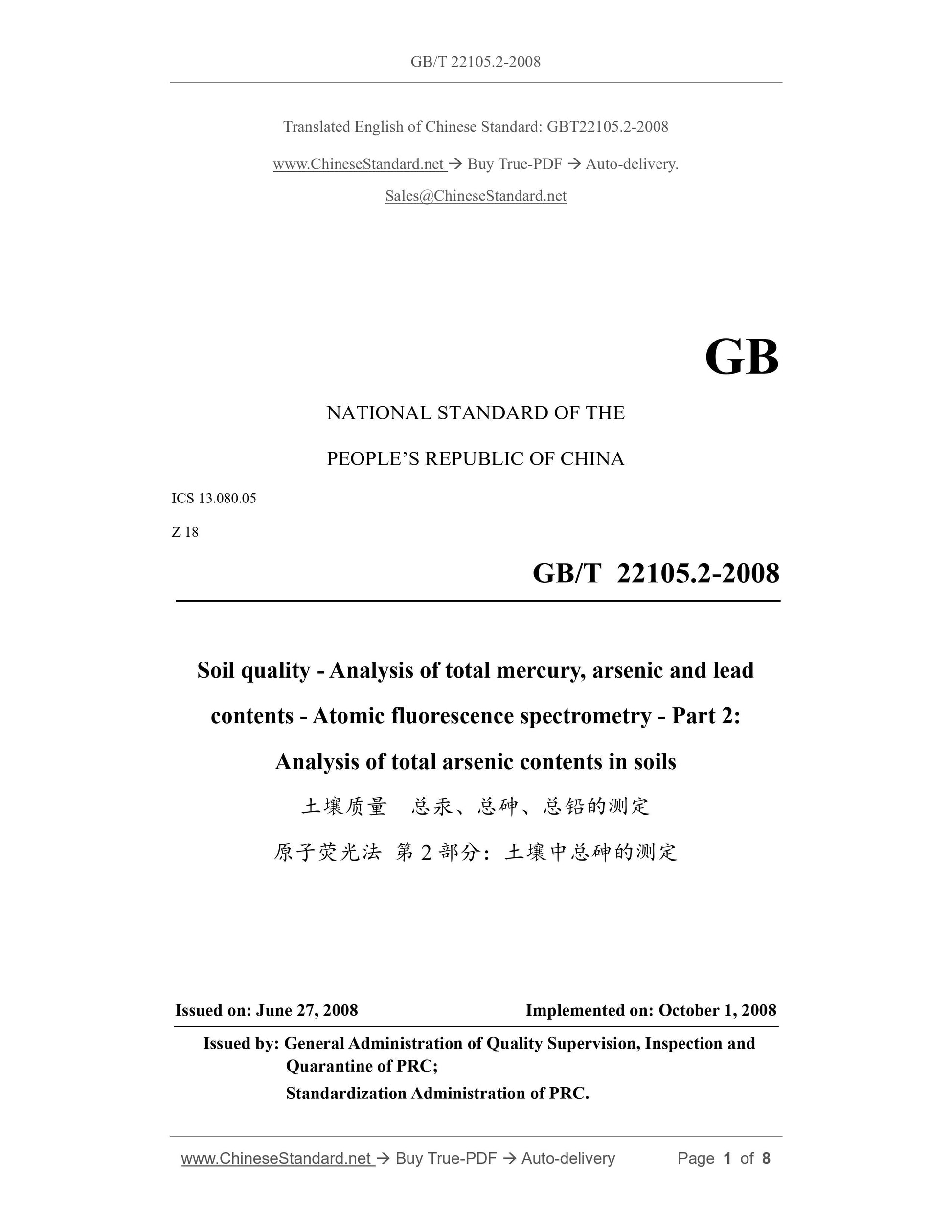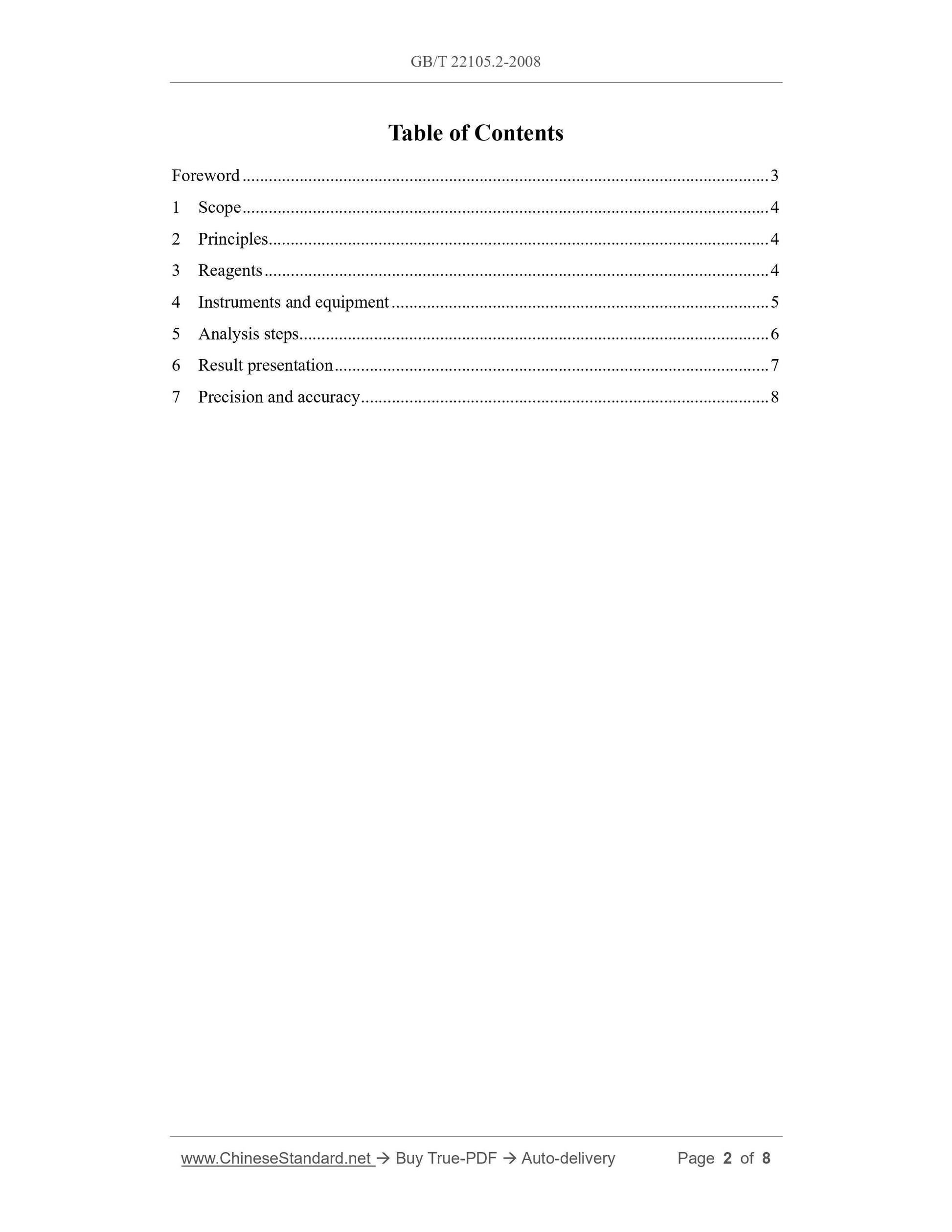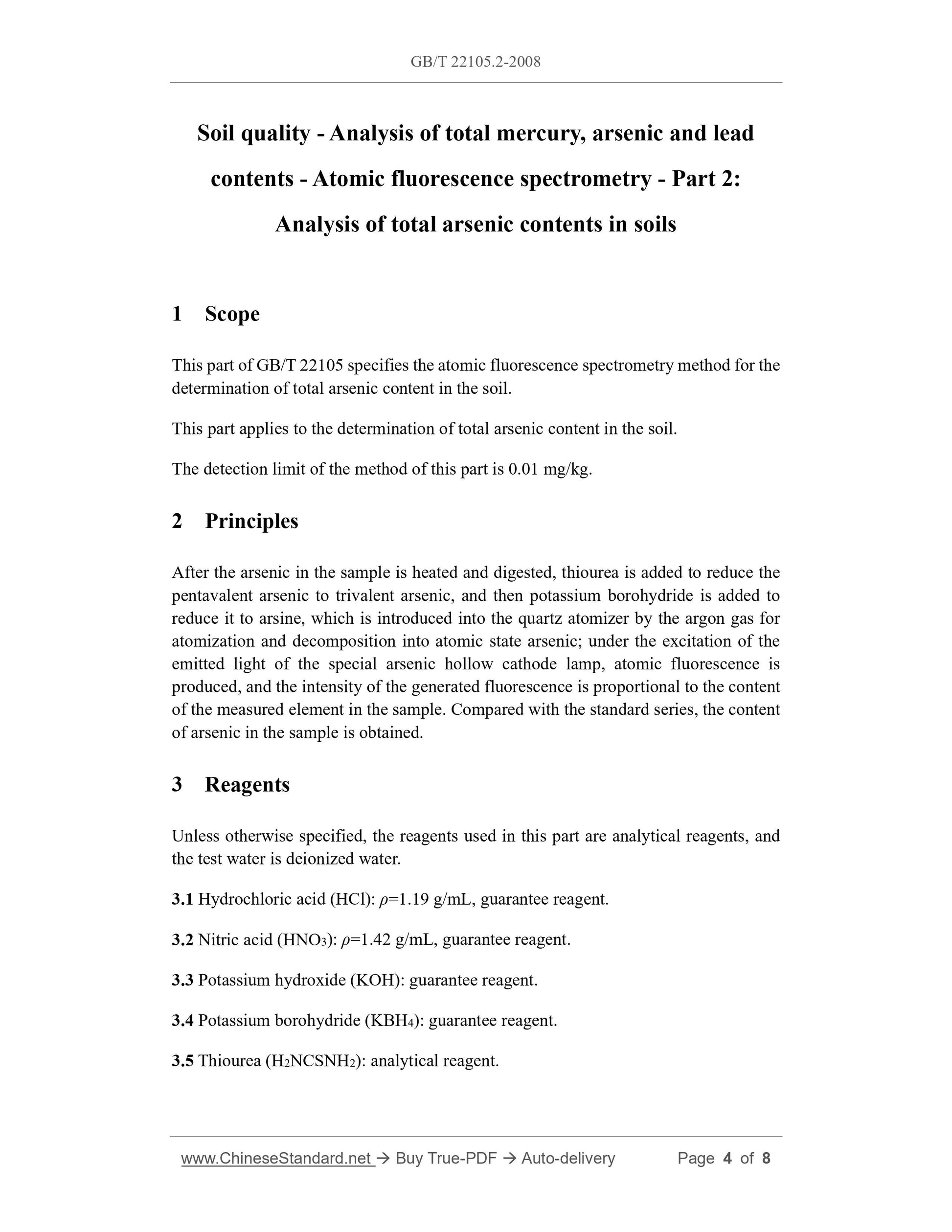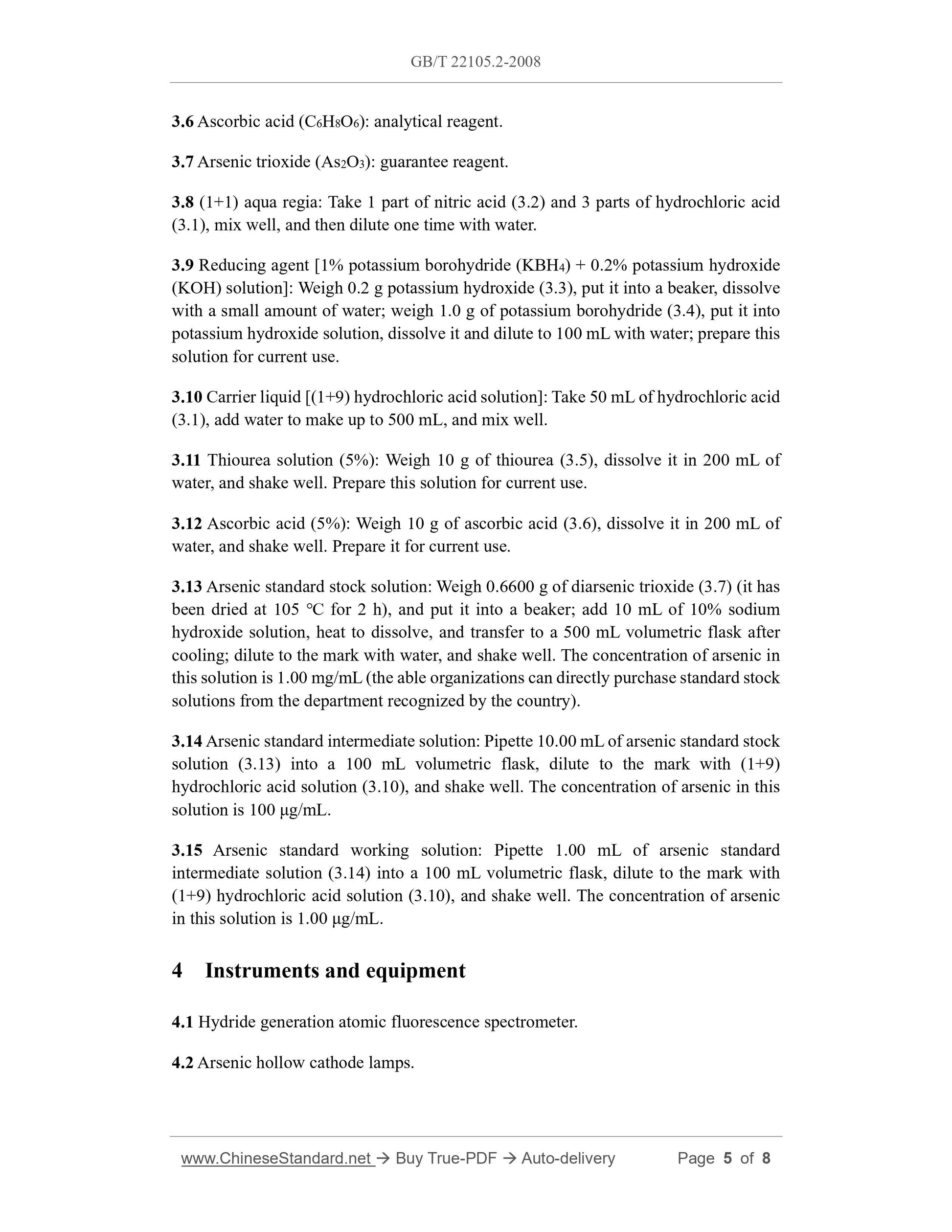1
/
of
4
PayPal, credit cards. Download editable-PDF and invoice in 1 second!
GB/T 22105.2-2008 English PDF (GBT22105.2-2008)
GB/T 22105.2-2008 English PDF (GBT22105.2-2008)
Regular price
$110.00 USD
Regular price
Sale price
$110.00 USD
Unit price
/
per
Shipping calculated at checkout.
Couldn't load pickup availability
Delivery: 3 seconds. Download true-PDF + Invoice.
Get QUOTATION in 1-minute: Click GB/T 22105.2-2008
Historical versions: GB/T 22105.2-2008
Preview True-PDF (Reload/Scroll if blank)
GB/T 22105.2-2008: Soil quality -- Analysis of total mercury, arsenic and lead contents -- Atomic fluorescence spectrometry -- Part 2: Analysis of total arsenic contents in soils
GB/T 22105.2-2008
GB
NATIONAL STANDARD OF THE
PEOPLE’S REPUBLIC OF CHINA
ICS 13.080.05
Z 18
Soil quality - Analysis of total mercury, arsenic and lead
contents - Atomic fluorescence spectrometry - Part 2:
Analysis of total arsenic contents in soils
ISSUED ON: JUNE 27, 2008
IMPLEMENTED ON: OCTOBER 1, 2008
Issued by: General Administration of Quality Supervision, Inspection and
Quarantine of PRC;
Standardization Administration of PRC.
Table of Contents
Foreword ... 3
1 Scope ... 4
2 Principles ... 4
3 Reagents ... 4
4 Instruments and equipment ... 5
5 Analysis steps ... 6
6 Result presentation ... 7
7 Precision and accuracy ... 8
Soil quality - Analysis of total mercury, arsenic and lead
contents - Atomic fluorescence spectrometry - Part 2:
Analysis of total arsenic contents in soils
1 Scope
This part of GB/T 22105 specifies the atomic fluorescence spectrometry method for the
determination of total arsenic content in the soil.
This part applies to the determination of total arsenic content in the soil.
The detection limit of the method of this part is 0.01 mg/kg.
2 Principles
After the arsenic in the sample is heated and digested, thiourea is added to reduce the
pentavalent arsenic to trivalent arsenic, and then potassium borohydride is added to
reduce it to arsine, which is introduced into the quartz atomizer by the argon gas for
atomization and decomposition into atomic state arsenic; under the excitation of the
emitted light of the special arsenic hollow cathode lamp, atomic fluorescence is
produced, and the intensity of the generated fluorescence is proportional to the content
of the measured element in the sample. Compared with the standard series, the content
of arsenic in the sample is obtained.
3 Reagents
Unless otherwise specified, the reagents used in this part are analytical reagents, and
the test water is deionized water.
3.1 Hydrochloric acid (HCl): ρ=1.19 g/mL, guarantee reagent.
3.2 Nitric acid (HNO3): ρ=1.42 g/mL, guarantee reagent.
3.3 Potassium hydroxide (KOH): guarantee reagent.
3.4 Potassium borohydride (KBH4): guarantee reagent.
3.5 Thiourea (H2NCSNH2): analytical reagent.
3.6 Ascorbic acid (C6H8O6): analytical reagent.
3.7 Arsenic trioxide (As2O3): guarantee reagent.
3.8 (1+1) aqua regia: Take 1 part of nitric acid (3.2) and 3 parts of hydrochloric acid
(3.1), mix well, and then dilute one time with water.
3.9 Reducing agent [1% potassium borohydride (KBH4) + 0.2% potassium hydroxide
(KOH) solution]: Weigh 0.2 g potassium hydroxide (3.3), put it into a beaker, dissolve
with a small amount of water; weigh 1.0 g of potassium borohydride (3.4), put it into
potassium hydroxide solution, dissolve it and dilute to 100 mL with water; prepare this
solution for current use.
3.10 Carrier liquid [(1+9) hydrochloric acid solution]: Take 50 mL of hydrochloric acid
(3.1), add water to make up to 500 mL, and mix well.
3.11 Thiourea solution (5%): Weigh 10 g of thiourea (3.5), dissolve it in 200 mL of
water, and shake well. Prepare this solution for current use.
3.12 Ascorbic acid (5%): Weigh 10 g of ascorbic acid (3.6), dissolve it in 200 mL of
water, and shake well. Prepare it for current use.
3.13 Arsenic standard stock solution: Weigh 0.6600 g of diarsenic trioxide (3.7) (it has
been dried at 105 ℃ for 2 h), and put it into a beaker; add 10 mL of 10% sodium
hydroxide solution, heat to dissolve, and transfer to a 500 mL volumetric flask after
cooling; dilute to the mark with water, and shake well. The concentration of arsenic in
this solution is 1.00 mg/mL (the able organizations can directly purchase standard stock
solutions from the department recognized by the country).
3.14 Arsenic standard intermediate solution: Pipette 10.00 mL of arsenic standard stock
solution (3.13) into a 100 mL volumetric flask, dilute to the mark with (1+9)
hydrochloric acid solution (3.10), and shake well. The concentration of arsenic in this
solution is 100 μg/mL.
3.15 Arsenic standard working solution: Pipette 1.00 mL of arsenic standard
intermediate solution (3.14) into a 100 mL volumetric flask, dilute to the mark with
(1+9) hydrochloric acid solution (3.10), and shake well. The concentration of arsenic
in this solution is 1.00 μg/mL.
4 Instruments and equipment
4.1 Hydride generation atomic fluorescence spectrometer.
4.2 Arsenic hollow cathode lamps.
Get QUOTATION in 1-minute: Click GB/T 22105.2-2008
Historical versions: GB/T 22105.2-2008
Preview True-PDF (Reload/Scroll if blank)
GB/T 22105.2-2008: Soil quality -- Analysis of total mercury, arsenic and lead contents -- Atomic fluorescence spectrometry -- Part 2: Analysis of total arsenic contents in soils
GB/T 22105.2-2008
GB
NATIONAL STANDARD OF THE
PEOPLE’S REPUBLIC OF CHINA
ICS 13.080.05
Z 18
Soil quality - Analysis of total mercury, arsenic and lead
contents - Atomic fluorescence spectrometry - Part 2:
Analysis of total arsenic contents in soils
ISSUED ON: JUNE 27, 2008
IMPLEMENTED ON: OCTOBER 1, 2008
Issued by: General Administration of Quality Supervision, Inspection and
Quarantine of PRC;
Standardization Administration of PRC.
Table of Contents
Foreword ... 3
1 Scope ... 4
2 Principles ... 4
3 Reagents ... 4
4 Instruments and equipment ... 5
5 Analysis steps ... 6
6 Result presentation ... 7
7 Precision and accuracy ... 8
Soil quality - Analysis of total mercury, arsenic and lead
contents - Atomic fluorescence spectrometry - Part 2:
Analysis of total arsenic contents in soils
1 Scope
This part of GB/T 22105 specifies the atomic fluorescence spectrometry method for the
determination of total arsenic content in the soil.
This part applies to the determination of total arsenic content in the soil.
The detection limit of the method of this part is 0.01 mg/kg.
2 Principles
After the arsenic in the sample is heated and digested, thiourea is added to reduce the
pentavalent arsenic to trivalent arsenic, and then potassium borohydride is added to
reduce it to arsine, which is introduced into the quartz atomizer by the argon gas for
atomization and decomposition into atomic state arsenic; under the excitation of the
emitted light of the special arsenic hollow cathode lamp, atomic fluorescence is
produced, and the intensity of the generated fluorescence is proportional to the content
of the measured element in the sample. Compared with the standard series, the content
of arsenic in the sample is obtained.
3 Reagents
Unless otherwise specified, the reagents used in this part are analytical reagents, and
the test water is deionized water.
3.1 Hydrochloric acid (HCl): ρ=1.19 g/mL, guarantee reagent.
3.2 Nitric acid (HNO3): ρ=1.42 g/mL, guarantee reagent.
3.3 Potassium hydroxide (KOH): guarantee reagent.
3.4 Potassium borohydride (KBH4): guarantee reagent.
3.5 Thiourea (H2NCSNH2): analytical reagent.
3.6 Ascorbic acid (C6H8O6): analytical reagent.
3.7 Arsenic trioxide (As2O3): guarantee reagent.
3.8 (1+1) aqua regia: Take 1 part of nitric acid (3.2) and 3 parts of hydrochloric acid
(3.1), mix well, and then dilute one time with water.
3.9 Reducing agent [1% potassium borohydride (KBH4) + 0.2% potassium hydroxide
(KOH) solution]: Weigh 0.2 g potassium hydroxide (3.3), put it into a beaker, dissolve
with a small amount of water; weigh 1.0 g of potassium borohydride (3.4), put it into
potassium hydroxide solution, dissolve it and dilute to 100 mL with water; prepare this
solution for current use.
3.10 Carrier liquid [(1+9) hydrochloric acid solution]: Take 50 mL of hydrochloric acid
(3.1), add water to make up to 500 mL, and mix well.
3.11 Thiourea solution (5%): Weigh 10 g of thiourea (3.5), dissolve it in 200 mL of
water, and shake well. Prepare this solution for current use.
3.12 Ascorbic acid (5%): Weigh 10 g of ascorbic acid (3.6), dissolve it in 200 mL of
water, and shake well. Prepare it for current use.
3.13 Arsenic standard stock solution: Weigh 0.6600 g of diarsenic trioxide (3.7) (it has
been dried at 105 ℃ for 2 h), and put it into a beaker; add 10 mL of 10% sodium
hydroxide solution, heat to dissolve, and transfer to a 500 mL volumetric flask after
cooling; dilute to the mark with water, and shake well. The concentration of arsenic in
this solution is 1.00 mg/mL (the able organizations can directly purchase standard stock
solutions from the department recognized by the country).
3.14 Arsenic standard intermediate solution: Pipette 10.00 mL of arsenic standard stock
solution (3.13) into a 100 mL volumetric flask, dilute to the mark with (1+9)
hydrochloric acid solution (3.10), and shake well. The concentration of arsenic in this
solution is 100 μg/mL.
3.15 Arsenic standard working solution: Pipette 1.00 mL of arsenic standard
intermediate solution (3.14) into a 100 mL volumetric flask, dilute to the mark with
(1+9) hydrochloric acid solution (3.10), and shake well. The concentration of arsenic
in this solution is 1.00 μg/mL.
4 Instruments and equipment
4.1 Hydride generation atomic fluorescence spectrometer.
4.2 Arsenic hollow cathode lamps.
Share
